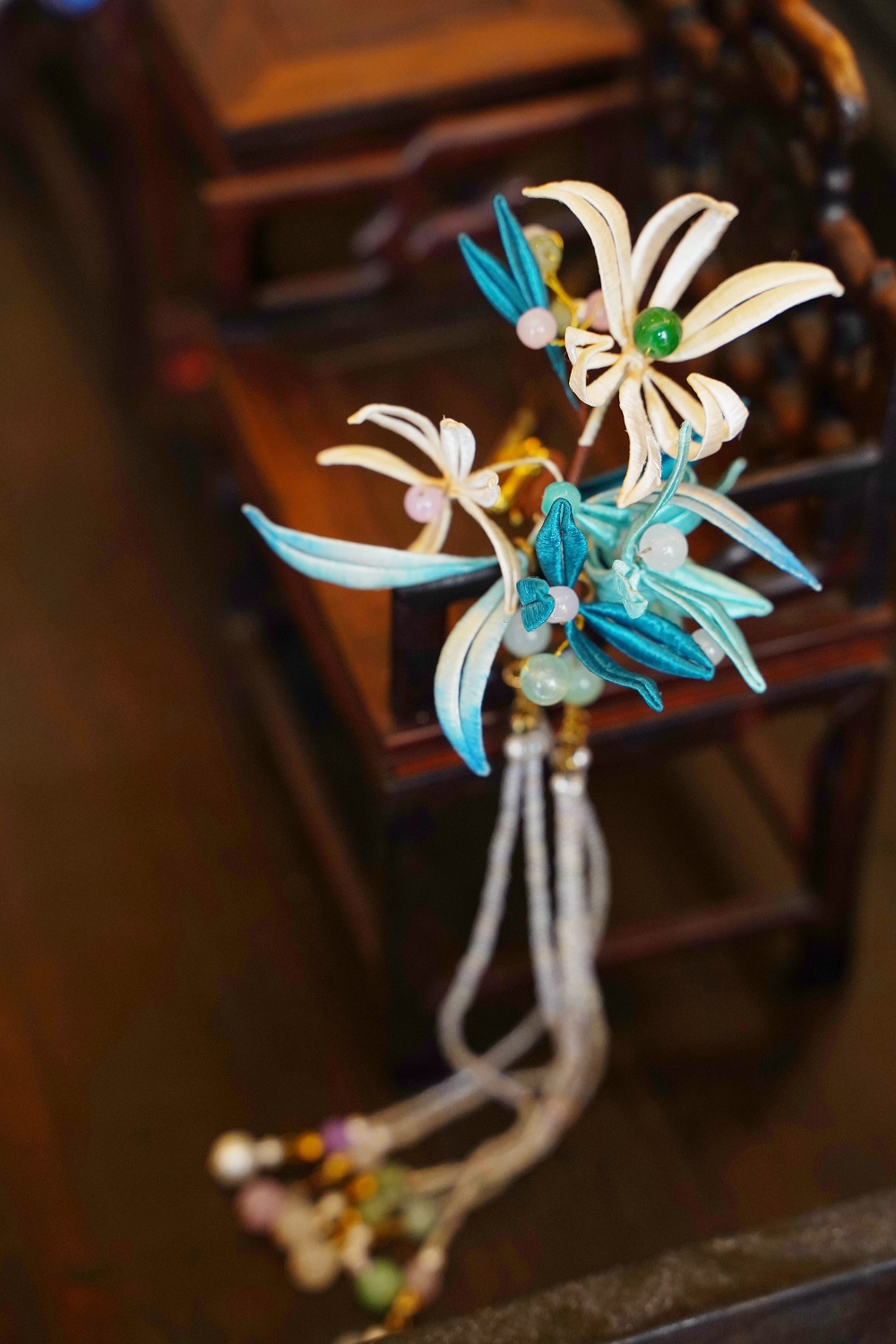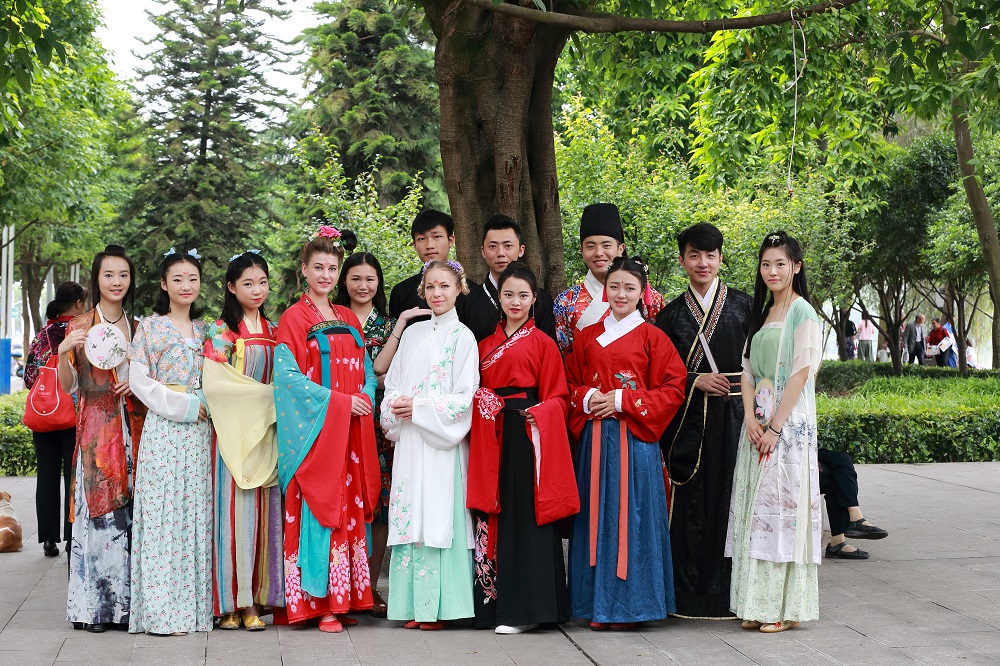Hairpin and Hanfu
For the World to Appreciate the Beauty of China
簪花汉服
让世界看到中国之美

中国汉服秀亮相法国巴黎。
On her head a golden sparrow hairpin; At her waist a green jade pendant. While encompassing her lovely form, Pearls, coral and blue glass beads around. The Hanfu show held in the Paris street displayed the beauty of traditional Chinese clothing and shared the glamor of French classical architectures, bringing a unique cultural collision between the east and the west.
“This photo was taken on the ‘2018 Impression of China, Beauty of Chongqing’ International Culture and Art Tour in Paris (France),” Said Zou Shenghe, Chair of Hanfu Culture Association of Jiangjin District of Chongqing and founder of Huaben Sinology School. Zou, dressed in Hanfu, was introducing this photo to the journalist.
Hairpin and Hanfu
At the exhibition area of the sinology school, many eye-catching Hanfu accessories are on display, including a glass hairpin in the shape of peach blossoms, a cap with an inlaid pattern of two dragons playing with a pearl, a necklace with bead tassels, a silver comb and so on. “In ancient China, accessories were often used as love tokens by young men and women to represent and express their pure affection,” said Zou Shenghe, with a hairpin in his hand. The peach-blossom-patterned hairpin was made with colorful glass flakes connected by one single string and intertwined in the shape of peach blossoms. It symbols lingering love, faithfulness, and earnestness.
The original materials for glass-making were extracted from the by-products of bronze. Glass was rich in color, so the ancient Chinese people named it “colorful stone”. Ordinary people can hardly get even one piece of glass, no surprise that it was more cherished than jade.
In June 2008, traditional glass-firing techniques were included in the second batch of the national list of intangible cultural heritage. The glass hairpin made by the Huaben Sinology School was also selected into the 2021 List of Chongqing Gifts for Diplomatic Purposes.
On the wall of Huaben Sinology School is hanging several restored exquisite Han clothing, such as the coronation suit of the Emperor Wu of Han, a crane patterned dress of Madam Widow Qing, Madam Xinzhui’s dragon design Quju (curly robe), and so on.
“This crane-patterned dress belonged to Madam Widow Qing in the Qin Dynasty. She was an entrepreneur, the queen of cinnabar in China’s history. Her hometown was in the current Changshou District, Chongqing. We expected to express the elegance, intellectuality, and dignity of Madam Widow Qing when restoring this dress. So we made a black silk top with a red chiffon skirt, wrapping a crane-patterned wide-sleeve coat,” Zou Shenghe introduced.
Zou’s Story with Hanfu
Zou Shenghe’s hometown is Longhui County, Shaoyang City, Hunan Province. He is a veteran. His story with Hanfu started from a folk art activity at the Dragon Boat Festival several years ago. His breath was taken by the exquisiteness of Hanfu and the traditional ritual elegance. “Hanfu is one of the traditional Chinese clothing. It encompasses the dying, weaving, embroidery and other traditional techniques and aesthetic views, inheriting 30 plus techniques of traditional Chinese arts and crafts listed in China’s intangible cultural heritage. I hope to be an ambassador of Hanfu culture to advocate its inheritance.” Zou Shenghe told us that he has been obsessed with Hanfu since the activity and made his decision to study Hanfu culture.
In 2014, Zou Shenghe decided to establish a Jiangjin Hanfu Club in his wife’s hometown — Jiangjin District, Chongqing. In the same year, he established the Hanfu Culture Association of Jiangjin District, Chongqing. In 2015, he started Chongqing Huaben Han Culture Dissemination Co., Ltd. In 2019, he opened the Huaben Sinology School, which is the first sinology school with Hanfu as its highlight.
Zou Shenghe also invited experts to conduct research and dissemination plans on Hanfu culture. He organized students to learn Hanfu culture and relevant rituals, held lectures and public activities related to traditional Chinese festivals and Hanfu culture. In 2021, the Hanfu Culture Association of Jiangjin District was authorized as a humanities and social sciences knowledge-spreading base in Chongqing.
Hanfu Culture Export
Clothing is a living interpretation of culture. But to Zou Shenghe, Hanfu is not simply clothing, but a symbol of traditional Chinese culture and ritual. In recent years, he has not only made efforts to recommend Hanfu to more Chinese people, but also explored ways to introduce it to the world.
In 2018, Huaben company brought its Hanfu to the “Impression of China, Beauty of Chongqing” International Culture and Art Tour in Paris (France). The Hanfu show stopped Paris citizens’ steps and won high praise from Alexandra Cordebard, mayor of the 10th district of Paris. During the 14th China (Shenzhen) International Cultural Industries Fair (ICIF), Huaben company introduced its Hanfu, accessories, and Hanfu culture through live-streaming to expand Hanfu’s influence. In the 2020 Chongqing Tourism and Culture Conference, the Jiangjin Hall designed and decorated by Huaben company attracted a large number of visitors to enjoy its Hanfu show and cultural creative products.
“I hope to introduce Hanfu culture to everyone in China and to the world, so more people will understand, love, and spread Chinese culture. I want to export Hanfu culture and let the world enjoy this Chinese exquisiteness.”
Photo by Interviewee (except signed pictures)
头戴金爵钗,腰佩翠琅玕。明珠交玉体,珊瑚间木难……亮相法国巴黎街头的汉服秀展示出中国服章之美,与法国古典主义建筑交相辉映,上演了一场中西文化的别样碰撞。
“这是参加2018年‘中国印象·秀美重庆’文化艺术国际巡游法国行活动拍摄的。”重庆市江津区汉服文化协会会长、华本汉学馆创始人邹声和身着汉服,向记者介绍这张照片的由来。

琉璃簪花。摄影 邓思源
簪花与汉服
汉学馆饰品展示区,桃夭琉璃簪花、花丝镶嵌双龙戏珠纹发冠、璎珞项链、银梳等琳琅满目的汉服配饰引人注目。“中国古代,饰品常常被作为定情信物,是纯洁爱情的象征和表达方式。”邹声和拿起一款簪花介绍,这款桃夭琉璃簪花,选用流云漓彩、美轮美奂的琉璃片,由一根丝线缠绕而成,恰如情侣相思之情,表达的是一心一意,认真做人的进步思想。
中国古代制作琉璃的材料,最初是从铸造青铜器产生的副产品中经过提炼加工得到的。琉璃的颜色多种多样,古人也叫它“五色石”。由于民间很难得到,所以琉璃比玉器还珍贵。
2008年6月,琉璃烧制技艺入选第二批国家级非物质文化遗产名录。华本汉学馆打造的琉璃簪花入选2021“重庆好礼·外事礼品”。
汉学馆墙上挂着由华本汉学馆研究复原的汉武大帝加冕礼服、巴寡妇清仙鹤礼服、辛追夫人龙纹曲裾等一系列做工精致的汉服。
“这一件是巴寡妇清仙鹤礼服,来源于秦朝企业家巴寡妇清,她是重庆长寿人,中国历史上的丹砂女王。我们复原这件礼服时,重点展现巴寡妇清的服饰与神韵,知性优雅、端庄脱俗的气质与美感:黑色真丝上衣,红色雪纺下裳,仙鹅印花大袖霞披外套。”邹声和娓娓道来。

华本汉学馆。
结缘汉服
邹声和是湖南邵阳隆回县人,也是一名退伍军人。他与汉服结缘,源于多年前的一次端午节民俗文化活动,被汉服展示出的美和汉礼之端深深震撼。“汉服是中国传统服饰,汇聚了染、织、绣等工艺和美学,承载了30多项中国非物质文化遗产以及中国工艺美术技艺。我想成为汉服文化推介者,助力汉服文化传承。”从那以后,邹声和对汉服着了迷,并决定好好研究汉服文化。
2014年,邹声和选择在其爱人的家乡重庆市江津区创立江津汉服社,同年成立重庆市江津区汉服文化协会;2015年,成立重庆市华本汉文化传播有限公司;2019年开设华本汉学馆,这也是重庆市第一家以汉服文化为主题的汉学馆。
在这里,邹声和邀请学术专家进行汉服文化的研究和推广,组织学员学习汉服文化和汉服礼仪,举办汉服文化学术讲座,以及传统节日和汉服文化的公益活动。2021年,江津区汉服文化协会获批重庆市人文社会科学普及基地。
汉服“出海”
服饰是文化的生动体现。汉服在邹声和心中不仅是衣服,更代表传统文化和礼仪。近年来,在琢磨“墙内开花”的同时,他更努力推动汉服“走出去”,让世界看到中华优秀传统文化。
2018年,华本汉服参与“中国印象·秀美重庆”文化艺术国际巡游法国行活动,携中国汉服秀亮相法国巴黎街头,引得不少巴黎民众驻足欣赏,巴黎第十区区长科尔德巴尔更是对汉服和饰品赞不绝口;第十四届中国(深圳)国际文博会,华本汉服通过网络直播介绍汉服及饰品,宣传汉服文化,扩大汉服影响力;2020重庆文旅会,华本汉文化公司设计布展的江津馆通过丰富多彩的汉服表演、琳琅满目的文创产品,吸引大量嘉宾前来看展。
“我的愿望是把汉服文化推向全国,推向世界,让更多人了解、热爱和发扬中国文化。汉服‘出海’,让世界看到中国之美。”

俄罗斯友人参加汉服体验活动。
文/刘丁睿
图片/除署名外由受访者提供

重庆与世界杂志社 Copyright 2000-2023 Cqworld.cn All Rights Reserved. 渝ICP备:05006161/渝公网安备50010302504769号
国内发行:重庆市报刊发行局\杂志社自发 | 国外发行:中国国际图书贸易总公司
地址:重庆市渝中区学田湾正街1号广场大厦11F,举报电话:023-68898926,违法和不良信息举报中心热线:12377

微信公众号